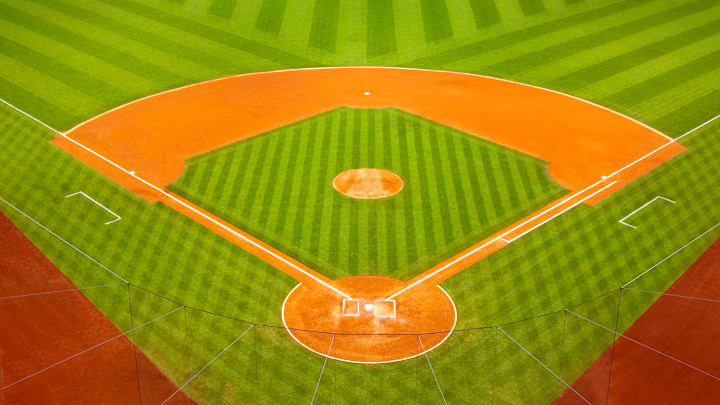Anyone who has ever had a skilled laborer eyeball a plumbing problem or had a body shop assess car damage is probably familiar with the phrase ballpark figure. It’s what you ask for when you want a rough idea of the cost, time, or dimensions of an unrealized project.
“What’s the ballpark figure on fixing my garage door,” you might say. Or, “Ballpark, how long it will take to get me a ballpark estimate.”
But why do we use ballpark as a verb or as a means of making guesstimations?
The Origin of Ballpark Figure

As you no doubt know, ballpark figure stems from a long list of slang terms derived from baseball. The Oxford English Dictionary dates its earliest use as a figurative term to 1943, citing it as United States Air Force slang for a general and inexact geographical area. It was later adopted by the space program: A capsule expected to land in a general part of the ocean might be said to be landing “within the ballpark area.”
Ballpark as a verb, or what the OED defines as “to estimate the approximate value, amount, extent, etc.” of something, dates to 1957, when Aviation Week wrote that “Once this pattern is ‘ball-parked’ for approximate actual size, it’s ready for detail design.”
The same year also saw a syndicated newspaper columnist alert readers to new “Pentagon language” in circulation in Washington, defining the government’s use of ballpark figure as a “very rough estimate” of program costs.
A scintillating citation also comes from 1973’s Basic Electronic Test Procedures, which states “Since we are ‘ball-parking’ rather than making a precise measurement, the physical position of the rheostat wiper arm will give us the desired information.”
Ballpark, it seemed, was a favorite among bureaucrats and engineers who liked it as a euphemism for estimate.
You May Also Like:
- Great Expectorations: Why Baseball Players Spit So Much
- What’s That Round Thing on a Baseball Bat?
- The Origins of All 30 MLB Team Names
- There’s an Optical Illusion Hidden in the MLB Logo
Add Mental Floss as a preferred news source!
Numerous phrases and metaphors populate ballpark in this context. One might get or offer a ballpark figure, ballpark a number, and find that dueling figures are either in the same ballpark—or not even in the ballpark.
But what does a ballpark, which since the late 1800s is widely known to mean a baseball field with spectators, have to do with making rough estimations? That’s a bit trickier to answer.
In the Ballpark
Columnist and wordsmith William Safire touched on the topic back in 1981, broaching it with lexicographer Stuart Flexner. According to Flexner, to be in the ballpark meant being within a wide but reasonable spectrum of assessment, just as being in a literal ballpark offered some idea of geographic location without being overtly specific. In both cases, allowances were being made for being inexact.
Inside Baseball: Slang Terms Unique to the Game
Slang | Definition |
|---|---|
Chin Music | A ball that comes uncomfortably close to a batter’s chin |
Hose | A player’s throwing arm |
Nubber | A pathetic ground ball |
Aspirin Tablet | A fastball so quick it looks like a tiny white pill |
Eephus | A slow, arching pitch |
The in-or-out-of-ballpark origin is sensible, but there are alternative explanations. One possibly-apocryphal origin has it that when baseball team owners or managers called in scores and attendance numbers to reporters, they might inflate or otherwise fudge the latter to hide a low turnout. A ballpark figure was therefore one that shouldn’t be counted on for accuracy.
Another possibility is that it was difficult for teams or stadium owners to perform an exact headcount of attendees at games, leading commentators or reporters to take a rough guess. The phrase to ballpark came to mean “making an inexact observation,” and one that shouldn’t hold anyone responsible for any error.
The Grim Origins of Murderers' Row |
|---|
In baseball, murderers’ row is an idiom that was once used to describe a formidable line-up of batters. In common usage, it can summarize any impressive group of people. But its origins actually date to the 1830s, when a new Manhattan prison, formally known as the Halls of Justice, opened. Inside its walls was a corridor devoted exclusively to killers, which was declared “murderers’ row” by staff and press alike. |
However ballpark figure originated, it’s clearly become one of the most ubiquitous metaphors around. Sports idioms are common, but what helped phrases derived from baseball take off was how heavily the game—which predated subsequent pastimes like football or basketball—was covered in the magazines and newspapers of the 1800s and 1900s. Papers didn’t have sports sections so much as they had baseball sections, making the terminology hard to miss.
While this might not be the most concrete etymology in the world, it’s certainly in the ballpark.
